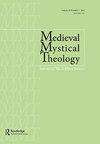An Introduction from the Editor of Medieval Mystical Theology
IF 0.3
0 RELIGION
引用次数: 0
Abstract
On behalf of The Eckhart Society, I would like to welcome you to Medieval Mystical Theology 28.2. All the papers in this issue are taken from the 31st Annual Eckhart Society Conference, the theme of which was: Wellness and Vulnerability. The conference was conceived and organized by Daniel G. W. Smith, and in the section that follows he will tell you more about the conference itself. Before doing so, I am delighted to introduce you to each of the papers with a view to rousing your interest. Naturally, the papers vary in length and density, which is reflected in the relative length of each of my introductions. The first paper, by Oliver James Keenan O.P., is titled, ‘The Politics of Sacred Vulnerability: Reading Martha Fineman with Meister Eckhart’. The paper begins with an analysis of the scope of vulnerability and asserts that it will give a positive theological account of vulnerability as a mode of human flourishing. This said, Keenan is aware of the potentially provocative nature of such an endeavour and thus makes a useful distinction between vulnerability and precarity. From here, Keenan provides a breakdown of ‘universal human vulnerability’ as set out in the work of Martha Fineman. A focus on the myth of invulnerability seeks to offer new insights and approaches into how vulnerability is realized as precarity, and how responses to this promote human flourishing through resilience. It also strongly criticizes various spiritual notions of invulnerability, including ‘thin readings’ of Meister Eckhart. However, there is a divine element of Eckhart’s spirituality which indicates that our vulnerability is not ‘ontologically basic’, and this can serve as a ‘supportive critique and development of Fineman’s attack of the myth of invulnerability’. Before proceeding to explore how Eckhart’s thinking might supplement Fineman’s proposals, Keenan provides an analysis of inherent vulnerabilities. The next section considers the topic of Eckhart’s dual-aspect anthropology, and here Keenan employs Eckhart’s thought to question an ‘unduly comfortable dualism’ and ‘contrastive antagonism’ in Fineman’s work. In response, a ‘spiritual conjunction’ is elucidated in Eckhart’s anthropology between vulnerability and invulnerability, that sees the suspended subject, ‘straddling and mediating between two metaphysical and noetic registers’. But this topic is open to misinterpretation, and so Keenan provides a subtle articulation of its significance. From here, then, Keenan is able to radically rethink the meaning of vulnerability on Eckhartian terms, and this leads to a new section, titled, An Eckhartian Re-Location of Vulnerability. In the final part, Keenan draws cautious parallels that this thinking has with the Trinity and Christology, before demonstrating how Eckhart’s most extensive discussion of vulnerability occurs in his Book of Divine Consolation. The paper closes with a reflective and honest Inconclusion. The second paper, by Daniel G. W. Smith, is titled, ‘Vulnerability, Dependence, and the Knowledge of God: Reflections on Meister Eckhart and Intellectual Disability’. Smith opens his essay by giving us a little bit of the background into disability theology, some of the problems inherent within it, and its relation to traditional theological teaching. The first section begins by helpfully defining ‘intellectual disability’, and here we get a sense of the troubling limits underlying this term. In the next section, Smith moves on to a topic titled, An Inclusive Anthropology, and here we learn how disability theologians challenge《中世纪神秘神学》编辑简介
我代表艾克哈特协会,欢迎大家来到中世纪神秘神学28.2。这期杂志的所有论文都摘自第31届艾克哈特学会年会,会议的主题是:健康与脆弱。这次会议是由Daniel G. W. Smith构思和组织的,在接下来的部分中,他将告诉你更多关于会议本身的信息。在此之前,我很高兴向您介绍每一篇论文,以引起您的兴趣。当然,论文的长度和密度各不相同,这反映在我每篇介绍的相对长度上。第一篇论文是奥利弗·詹姆斯·基南写的,题为《神圣的脆弱政治:与梅斯特·埃克哈特一起解读玛莎·法恩曼》。本文首先分析了脆弱性的范围,并断言它将对脆弱性作为人类繁荣的一种模式进行积极的神学解释。话虽如此,基南意识到这种努力的潜在挑衅性质,因此在脆弱性和不稳定性之间做出了有益的区分。从这里开始,基南提供了玛莎·费曼(Martha Fineman)著作中提出的“普遍的人类脆弱性”的分解。对坚不可摧神话的关注旨在提供新的见解和方法,以了解脆弱性如何被视为不稳定性,以及如何通过恢复力来促进人类繁荣。它还强烈批评各种坚不可摧的精神观念,包括梅斯特·埃克哈特(Meister Eckhart)的“单薄解读”。然而,埃克哈特的灵性中有一种神圣的元素,它表明我们的脆弱性不是“本体论上的基本”,这可以作为“对费曼对坚不可摧神话的攻击的支持性批评和发展”。在继续探讨Eckhart的思想如何补充Fineman的建议之前,Keenan提供了对内在脆弱性的分析。下一节将讨论埃克哈特的双重性人类学,在这里,基南运用埃克哈特的思想来质疑法恩曼作品中的“过度舒适的二元论”和“对比对抗”。作为回应,埃克哈特的人类学在脆弱和坚不可摧之间阐明了一种“精神上的结合”,它看到了悬浮的主体,“跨越和调解两种形而上学和精神领域”。但这个话题容易被误解,因此基南对其重要性进行了微妙的阐述。从这里开始,基南能够从根本上重新思考脆弱性在埃克哈特学派的意义,这就引出了一个新的章节,题为《埃克哈特学派对脆弱性的重新定位》。在最后一部分,基南谨慎地将这种思想与三位一体论和基督论进行了比较,然后展示了埃克哈特在他的《神圣的安慰》中是如何对脆弱性进行了最广泛的讨论的。这篇论文以发人深省和诚实的结束语结束。第二篇论文是丹尼尔·g·w·史密斯写的,题目是《脆弱、依赖和对上帝的认识:对埃克哈特和智障的反思》。史密斯在文章开头给我们介绍了一些残疾神学的背景,其中的一些固有问题,以及它与传统神学教学的关系。第一部分从对“智力残疾”的定义开始,在这里我们可以了解到这个术语背后令人不安的局限性。在下一节中,史密斯继续讨论一个主题,一个包容性的人类学,在这里我们了解残疾神学家是如何挑战的
本文章由计算机程序翻译,如有差异,请以英文原文为准。
求助全文
约1分钟内获得全文
求助全文

 求助内容:
求助内容: 应助结果提醒方式:
应助结果提醒方式:


